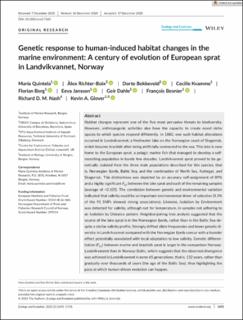| dc.description.abstract | Habitat changes represent one of the five most pervasive threats to biodiversity. However, anthropogenic activities also have the capacity to create novel niche spaces to which species respond differently. In 1880, one such habitat alterations occurred in Landvikvannet, a freshwater lake on the Norwegian coast of Skagerrak, which became brackish after being artificially connected to the sea. This lake is now home to the European sprat, a pelagic marine fish that managed to develop a self-recruiting population in barely few decades. Landvikvannet sprat proved to be genetically isolated from the three main populations described for this species; that is, Norwegian fjords, Baltic Sea, and the combination of North Sea, Kattegat, and Skagerrak. This distinctness was depicted by an accuracy self-assignment of 89% and a highly significant FST between the lake sprat and each of the remaining samples (average of ≈0.105). The correlation between genetic and environmental variation indicated that salinity could be an important environmental driver of selection (3.3% of the 91 SNPs showed strong associations). Likewise, Isolation by Environment was detected for salinity, although not for temperature, in samples not adhering to an Isolation by Distance pattern. Neighbor-joining tree analysis suggested that the source of the lake sprat is in the Norwegian fjords, rather than in the Baltic Sea despite a similar salinity profile. Strongly drifted allele frequencies and lower genetic diversity in Landvikvannet compared with the Norwegian fjords concur with a founder effect potentially associated with local adaptation to low salinity. Genetic differentiation (FST) between marine and brackish sprat is larger in the comparison Norway-Landvikvannet than in Norway-Baltic, which suggests that the observed divergence was achieved in Landvikvannet in some 65 generations, that is, 132 years, rather than gradually over thousands of years (the age of the Baltic Sea), thus highlighting the pace at which human-driven evolution can happen. | en_US |
